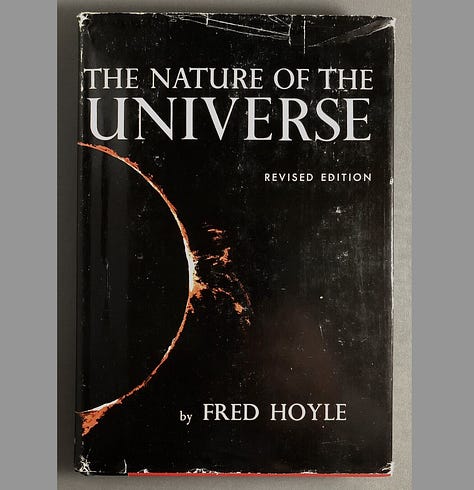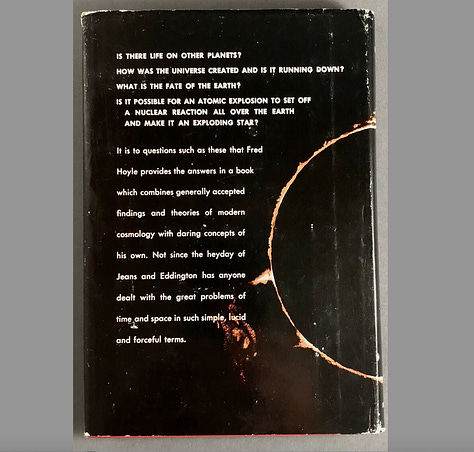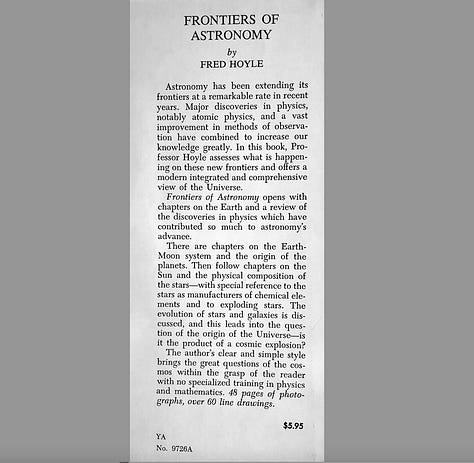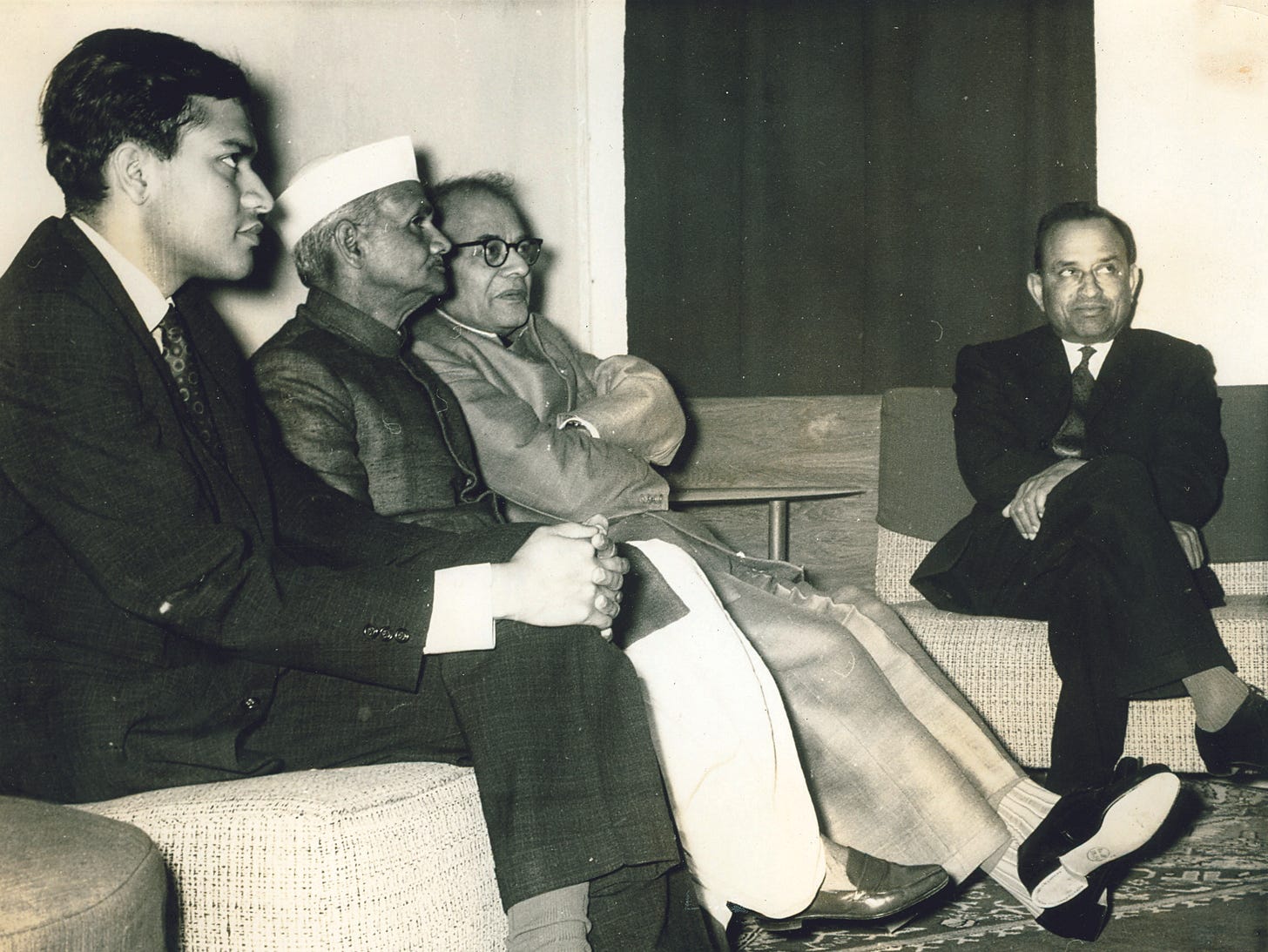Bharat Darshan 1965
A young scientist's journey of discovery and visit to his native country sets India abuzz with excitement for the stars.
Early days of my research
In a previous article, I described the role of the Royal Institution in science popularization. Towards the end, I referred to the influence of my Ph.D. guide, Fred Hoyle, in getting me interested in that venture. Hoyle had shown how an active scientist can play a vital role in conveying to the general public the importance of science in shaping our society. His talks on BBC radio in the 1950s on the way the remote world of astronomy can be brought to the public were very popular and were later printed as a book called The Nature of the Universe. Indeed, during my stay in England, I came across several young scientists who recalled in glowing terms how Fred Hoyle’s BBC lectures had inspired them to take up a career in astronomy.



Several astronomical findings in the early 1960s raised astronomy's subject far beyond the poetic image of “twinkle twinkle little star.” Radio astronomy, inputs from space, the application of advanced computing, esoteric objects like quasars, pulsars and black holes and studies of very distant parts of the universe added to the glamour of astronomy. Technological advances indicated that the universe has a lot of surprises in store for man. Scientific brainstorming was much in demand to appreciate them.
It was against this background that I received an invitation from the Editor of the distinguished science magazine Discovery to write an article surveying these developments. It was a “tall order” for a research student, and I hesitated about taking up the challenge. Fred Hoyle, my research guide and a past master in writing such articles, encouraged me to write, so I came up with an article on Gravitational Collapse. It described how a super-massive star a million times as massive as the Sun would end up having a strong self-gravity that pulls back its own light—in the early 1960s, astronomical evidence for such objects had begun emerging.
I was pleasantly surprised by the readers’ response. Requests for copy of the article, questions seeking further details, some arguing for alternative ideas, kept coming and Fred was pleased that a student of his was joining his crusade for science popularization.
In the meantime, I was making progress with my research at Cambridge, and landmarks like the Tyson Medal, W.A. Meek Scholarship, Smith’s Prize, and Fellowship at King’s College showed that my work was recognized. Hoyle and I published a number of papers in the prestigious Proceedings of the Royal Society. Thus, we were asked to present our work at a meeting of the Society on June 18, 1964.
Press and the cosmos
I recall that day as being a memorable day in my career. The meeting was well attended by famous scientists like Dirac, Bondi, Salam and others. What I did not expect was the publicity it got from popular press. I have tried to describe our work in a separate article in this series. The papers hailed it as a step forward in understanding the nature of gravitation after the work of Newton and Einstein. Some saw our joint work as international cooperation between Britain and India. But even beyond the popular press, science writers like John Maddox and editors of popular science like New Scientist wrote about it. The following Sunday, Hoyle and I had interviews. While Hoyle was used to publicity, this was a new experience for me.
As publicity snowballed, I received visits from Indian diplomats with proposals to plan a lecture tour of India. It would be a high-profile tour that normally brought distinguished personalities from foreign countries to India. While I felt very happy at the initiative from my own country, I played down the “VIP” nature of the proposed tour. Rather, I asked that preference be given to my lectures at university or college campuses and research-level interactions with interested scientists. Also, to tone down the publicity aspect, I suggested dates for my visit early in the following year in the hope that in the 9-10 month period, the “news value” of my visit would have disappeared.
Thus, a “Bharat Darshan” tour was arranged for February-March 1965 by the Indian Council for Cultural Relations (ICCR). I do not think a tour like that ever took place again. A few highlights of the tour described here will give some idea.
The Indian Republic Day (January 26 ) is an occasion for the Government of India to announce public honours (like peerage in the UK). I was pleasantly surprised when the honours list announced on 26 January, 1965 contained my name amongst Padmabhushan awardees. I felt that I was receiving such high honour too soon in my career.
My tour began in Delhi, where I met Prime Minister Lal Bahadur Shastri and Education Minister M.C. Chhagla. This despite my request to keep the tour limited to a low-key academic interaction. I was, however, very pleased to receive the appreciation from these VVIPs. It certainly helped me to popularize astronomy in India. Towards the end of my tour, I had the pleasure of meeting the President of India, Dr Sarvapalli Radhakrishnan. He had been a good friend of my father ever since his stay in BHU as Vice-Chancellor and had taken a personal interest in my career.
After Delhi, my tour included stops in Ahmedabad, Bombay, Hyderabad, Bangalore, Madras, Calcutta, Banaras, Agra, and back to Delhi. My lectures attracted tremendous response. At each place, the local organizers had to improvise. I, too, had to improvise the contents and level of my talks. I had planned them for student audiences in the UK–I learned to dilute them considerably. I also appreciated the interest the general public showed in astronomical discoveries.

I could go on and on with my experiences under the Bharat Darshan tour. The media in 1965 were less widespread than they are today. Nevertheless, the publicity given to a scientific event was remarkable. Even more remarkable was the impact it had on all reaches of the society.
I end by quoting one incident which took place when the official Bharat Darshan was just over, and I was visiting my uncle in Pune. The visit was private, but local authorities and media in Pune would not hear of it. Soon, official functions and sight-seeing excursions were arranged. The Municipal Commissioner, the Collector and some local dignitaries accompanied me on a visit to the Fort Simha Garh. As our motorcade passed a village at the foothills, we were stopped by the villagers. The Head of the Village approached us with a request: They had learned that a brilliant scholar (whom he described as modern Jnaneshwar!) would be passing through the village. The village would like to welcome him officially. Could he please be identified? Needless to say, I was deeply touched by this grassroots sentiment.



What a legend !!!
भावपूर्ण श्रद्धांजली 💐
A living legend. But very underrated in my opinion. We are grateful for your contribution sir.